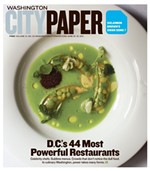Pronounced Dead
The first big-budget U.S. movie with a virtually all-Asian cast, Memoirs of a Geisha was considered such risky business that even Steven Spielberg ultimately passed on the project. After all, even Tom Cruise’s all-American boyishness couldn’t sell 2003’s The Last Samurai, whose script might have been pitched as Memoirs of a Geisha for guys. Now that the two movies can be compared, the similarities prove striking: Both are lushly appointed, expertly choreographed, and profoundly reactionary. Only Hollywood could make nearly back-to-back Orientalist fantasies celebrating the feudal roles that Japan’s own filmmakers have fiercely challenged for more than 50 years.
Like The Last Samurai, Memoirs of a Geisha is a well-researched, if misguided, tribute to Japan’s bad old days of patriarchy and strict social hierarchy. The primary scholarship was done by Arthur Golden, an American student of Japanese art and history, who spun the reminiscences of a veteran Kyoto geisha into an upmarket 1997 romance novel that became an international bestseller. Unlike a lot of recent English-language fictions about Japan, the book contains no brazen errors. But its glamorization of the geisha life and its accoutrements suggests that Golden has more feeling for elegantly embroidered silk kimonos than for the women who used to wear them.
The movie condenses the novel, of course, but it makes remarkably few alterations to the story of Chiyo (Suzuka Ohgo), a poor fisherman’s daughter. Sold to an okiya (geisha house) in the early 1930s, the 9-year-old grows up to be Sayuri (Ziyi Zhang), one of the most popular private entertainers of wealthy gentlemen in a city the film never identifies as Kyoto. (For the record, a geisha is not a prostitute, but that doesn’t mean her sexual favors can’t be purchased under the right circumstances and for the right price.) Director Rob Marshall and scripter Robin Swicord have changed one minor but significant character from Japanese to American. They’ve also turned Sayuri’s subtle Noh-style dance into a Kabuki-goes-Flashdance number that seems to serve primarily as a reminder that Marshall previously directed Chicago.
Convinced that Chiyo’s beauty will someday make her a formidable competitor, imperious top geisha Hatsumomo (Gong Li) tries to destroy the little girl’s chances. Hatsumomo is successful until another leading geisha, Mameha (Michelle Yeoh), offers to groom the girl, making an irresistible financial arrangement with the greedy owner of the okiya (and thus of Chiyo). Renamed Sayuri, the gray-eyed teenager becomes a sensation, and her virginity sparks a bidding war. Mameha intends for brusque and badly scarred war veteran Nobu (Koji Yakusho) to become Sayuri’s patron, but the girl has long preferred Nobu’s elegant friend, known only as the Chairman (The Last Samurai’s Ken Watanabe). He seems unattainable, but after Japan loses World War II, the ensuing disorder might just give Sayuri another shot. If only the movie did as well by her as does Golden’s fairy-tale scenario.
American audiences have never shown more antipathy toward subtitles than they do today, and even Sony-owned Columbia Pictures wasn’t about to spend millions on a movie in which Kyoto geishas speak their native language. So Memoirs of a Geisha opens with unsubtitled Japanese and quickly switches to English rendered in a disarray of accents. The three principal actresses are all ethnically Chinese, but with various levels of proficiency in the film’s primary tongue: Yeoh has worked for years in bilingual Hong Kong; Li has done a few films there, including one (Chinese Box) requiring English; and Zhang has never spoken the language onscreen before. Marshall’s solution was to have the geisha characters converse in a mincing style that—if perhaps not an unreasonable equivalent of the sing-song chatter of ’30s geishas—sounds ridiculous in English. While the actually Japanese Yakusho (previously seen stateside in such diverse fare as Shall We Dance, The Eel, and Pulse) and Watanabe deliver their lines credibly, the women talk like the supporting characters in a Bing Crosby–Bob Hope road comedy.
The movie was shot mostly in California, and primarily on sets, although it does make picturesque use of an actual Kyoto-area location, the Fushimi Inari Taisha shrine, to which love-struck Chiyo rushes breathlessly through its distinctive succession of orange-red gates. Stylistically, Marshall and cinematographer Dione Beebe have taken their cues more from flamboyant Chinese cinema than its austere Japanese counterpart. The tight framing and gliding camera suggest Wong Kar-Wai—whose vastly more expressive 2046 starred both Zhang and Li—but the most explicit homages are to another director who has worked with both actresses, Zhang Yimou. During Sayuri’s wartime sabbatical in the mountains, a montage of rushing water, flowing blood, and billowing fabric offers a visual abstract of Zhang’s Ju Dou.
Sayuri’s intramural battles with Hatsumomo and a fellow apprentice geisha known as Pumpkin (Youki Kudoh) also suggest Zhang’s Raise the Red Lantern, and Marshall’s movie might almost pretend to that film’s tragic grandeur. But the cast’s stilted line readings, Swicord’s trite dialogue, and Golden’s sappy plot all tend to reduce the director’s operatic ambitions to old-style B-movie melodrama. Fans of the novel may save Memoirs of a Geisha at the box office, but the picture will be on DVD soon enough, which gives its producers an opportunity to make amends: They should package it with a classic geisha drama—Kenji Mizoguchi’s Gion Festival Music, say, or Mikio Naruse’s Flowing—that shows how a life of ritualized subservience isn’t merely an exercise in art direction.

